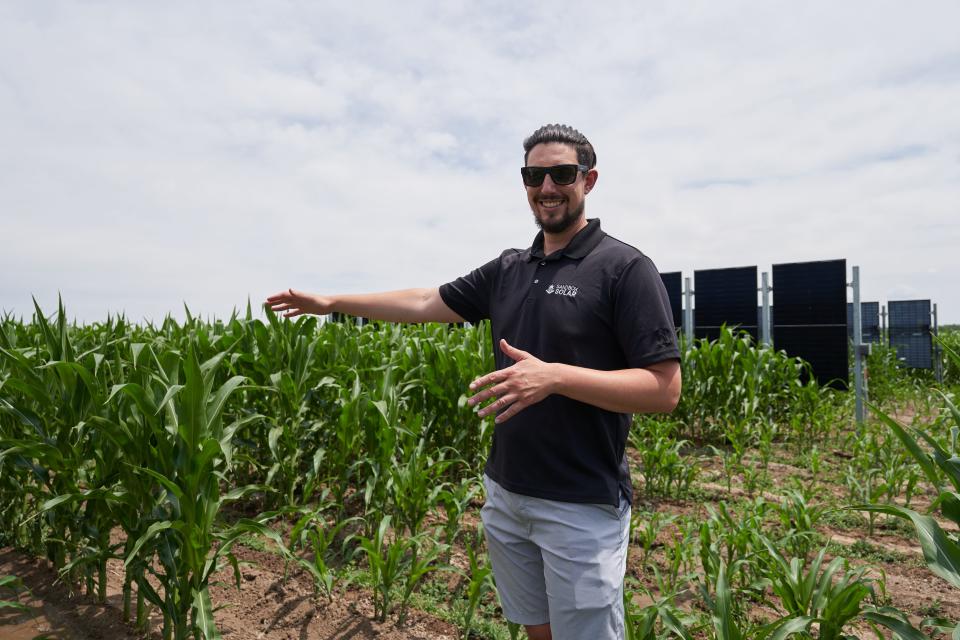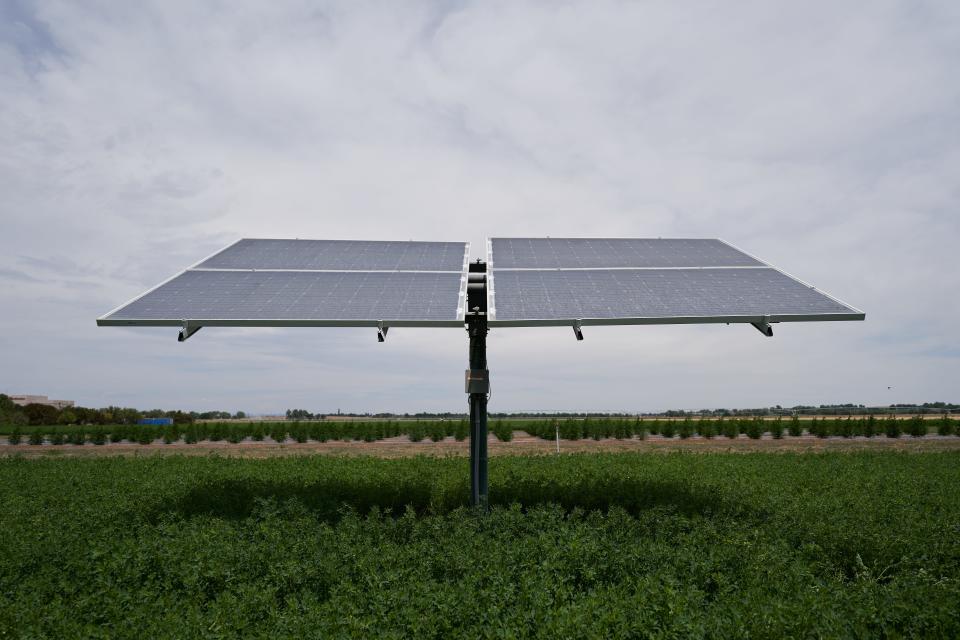This business teamed up with CSU to find out if crops and solar panels can help each other
As his shoes sank in the mud in a research field on a recent hot summer day, Ian Skor walked along neatly placed rows of corn. A few paces later, he got to a different kind of row in the field of crops.
Standing up between the growing plants were solar panels.
If Skor and CSU researchers can prove agriculture and solar panels not just coexist but thrive together — a practice known as agrivoltaics — it could be a solution to many of our modern-day problems like competing land use and a need for renewable energy.
How community solar led to a farming experiment
Back in 2015, Skor started his business out of his Subaru and a toolbox.
Fast forward a decade and Sandbox Solar has 30-plus employees that focus on installing solar panels and battery storage across the Front Range.
“We preach self-sufficiency. That's our main mission, driver and value,” Skor said. “Just trying to provide self-sufficiency for our homeowners, ourselves as a company, our community, and our nation as a whole to be less dependent on others and fossil fuels.”
While most of the company's projects have typically been residential, not everyone is in a place where they can install a solar panel.
That is where community solar came into the picture.
Community solar allows homeowners that have too much shade on their house or people who live in apartments to own a slice of a field that is somewhere else.
More: A high-profile Fort Collins solar farm is down, costing the city and solar investors
“They can own solar panels that are part of this bigger project and then receive that energy credit on their bill as if they had solar on their own,” Skor said.
While trying to find one of these projects, Skor started thinking about where a good location would be. Giant malls? On top of parking lots? A farm field?
He soon realized that there’s little available open land, and the few places that are available are highly sought after. With farmers having a similar issue, solar projects could create a land use conflict, Skor said.
“I contacted Dr. Mark E. Uchanski in the Horticulture Department at CSU and was like, ‘Hey, do you think we can grow crops underneath these things?’” Skor said.
He said Uchanski told him probably not, but they still gave it a shot.
“We put a panel on a greenhouse, grew spinach from seed and it grew up nearly just as well underneath the solar panel and that was a nice surprise,” Skor said.

Sandbox Solar applied for a grant from the U.S. Department of Agriculture and has since been expanding the research with CSU to see how crops respond to different amounts of sunlight.
For example, a traditional opaque panel will generate the most energy while providing the strongest shade. A semi-transparent panel doesn’t generate as much energy but allows a little more light to pass through — similar to the material used on a greenhouse roof.
Benefits for crops and beyond
Many factors play a role and not all plants respond in the same way, but research results seem promising.
“While some crops experienced reduced yield, other crops experienced no negative effect on productivity, and then some crops showed significantly improved performance from the shading effect,” a CSU tipsheet on agrivoltaics says.
For example, a study that was referenced showed that tomatoes could increase yields by 50% under shading.
And the benefits extend beyond crop performance. The shade produced by the solar panels can reduce the amount of water plants need, which can be valuable in places like Colorado, where water is a scarce resource.
“Agrivoltaic systems can also provide ecosystem services that are not realized with traditional (photovoltaic) systems. These systems maintain functionality of stormwater management, soil erosion prevention, and pollinator habitat. … Native pollinators benefit from established native flowering plants below solar panels, which can help reverse declining pollinator populations, especially in urban areas,” the CSU tipsheet says.

Taking the technology to new heights
At a different CSU site about one hour south in Denver, another researcher is studying this concept in a more urban setting.
Jennifer Bousselot, who grew up as an Iowan farm kid, married her high-school sweetheart, an engineer.
“He works on things in cities, so that means I had to bring farming to the city,” Bousselot said.
As an assistant professor of horticulture at Colorado State University, Bousselot now studies rooftop agrivoltaics in the Spur campus in Denver — growing food (for humans or pollinators) under solar panels on top of buildings.
“When you stop and really think about what our society is going to need, as our population increases … it's three things: it’s energy, it’s food, and it’s water,” Bousselot said. "So, getting creative and conserving or producing those three things in as many places as we can only contributes to strengthening the resources for our society.”
Some of the crops Bousselot and her team are studying include leafy greens, chili peppers and raspberries.
Similar to how Skor and the other researchers are testing different types of solar panels that allow more or less light, Bousselot wants to find that right balance.
“We're really interested in that sweet spot of making the most ideal conditions closer to what a greenhouse would be … while still generating energy,” Bousselot said.
Rooftop agrivoltaics bring many of the same benefits that its ground counterpart does, but it has some unique advantages based on its setting.
Green roofs can reduce the urban heat island effect by cooling down a building (bringing energy savings) as well as cooling the solar panels themselves.
More: In Fort Collins, how hot your sidewalk gets depends on where you live. Here's why.
“Panels operate the most efficiently at our ideal temperature" — 25 Celsius or 77 degrees Fahrenheit, Bousselot told the Coloradoan — "but each degree you go up, those panels actually lose efficiency."
When the temperatures get too hot, panels shut off and don’t generate energy when it's most needed, with our mid-July heat wave being a recent example, Bousselot said.
Locally produced food, like from a rooftop garden, can also have a smaller greenhouse gas footprint by not having to be driven or flown across the country.
‘Celebrating Colorado’
Earlier this year, Bousselot circumnavigated the world and noticed that green roofs are popular on every continent, except North America.
“A lot of it has to do with ownership, that's why policy is absolutely imperative to get this increasing livability of cities by adding green,” Bousselot said. “It has to be done through policy because otherwise there's just no incentive for individual building owners to contribute to society.”
Getting inspiration from the places she’s seen, Bousselot envisions cities here looking at rooftops and using them in a “Colorado style.”
“There's a big culture around enjoying beer. Well, I could imagine beer gardens with green roofs incorporated and growing hops,” Bousselot said. “All of these things are celebrating Colorado at the same time as utilizing these spaces that have been traditionally just overlooked.”
This article originally appeared on Fort Collins Coloradoan: CSU, Sandbox Solar team up for agrivoltaics experiment

